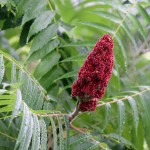I’m beginning to realize there is food all around us.
Wild carrots. Wild leeks. Dandelions (of course). Bergamot. Cattails. Wild strawberries. Ostrich fiddle heads. The list goes on.
I had the pleasure of taking a wild edibles* class at Humber College last weekend. It doesn’t get more local than this – just walking around a field or wood, seeing what you find growing there naturally and eating it.
Of course, exactly what we consumed was closely guided by Dave Arama of WSC Survival School, who teaches the class.
The surprising thing was how delicious some of these foraged foods were! I am not kidding. The young needles of the tamarack tree, eaten as a type of candy by native peoples, had me leaving the group and going back for seconds. As for the leaves of the dogtooth violet, I was going for thirds and fourths.
One of my favourite trees, the staghorn sumac, has edible berries that you can eat (similar to a pomegranate, but fuzzy) or make into a type of lemonade (sumac-ade, I suppose).
It was an eye-opener. The tricky part is knowing how to distinguish between your tasty edibles and the poisonous look alikes. For that you either need to commit to the learnin’ or have an expert with you at your side.
Thanks David! It was fun. I’m looking at my surroundings a little differently now and looking forward to the next course on June 4!
*Course title: Edible Plants, An Introduction
